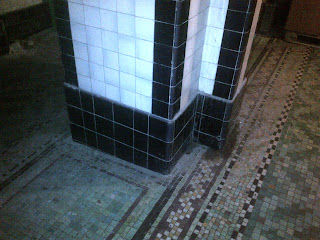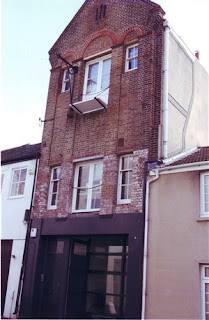- Brighton Station
- North Laine
- Embassy Court
Stood under the porte cochère Jackie enthusiastically took us through the early plans for station, which was essentially built on the Downs surrounded by glorious countryside as the main body of the city had yet to reach that far north. It's location allowed the London & Brighton Railway Company to build a terminus for both its London line and its Shoreham line, the latter opened first in 1840, very early in Britain's railway story.
We then moved indoors and followed Jackie up to the 1st floor L&BR boardroom, now sadly subdivided, but with some stunning coving and ceiling detailing recently exposed and restored. After a cantor through the construction, opening and then later expansion of the station accompanied with various visual aides we were back on the concourse and following the line of the old cab road, now enclosed beneath platform 8. We also looked at the entry to the old goods railway tunnel that cuts across the platforms diagonally before ending in Trafalgar St. The southern part of the tunnel was used as railway offices until station restoration.
We admired the current round of refurbishment, which includes the reinstatement of heritage windows and the demolition of the ugly departure board and WHSmith building and speculated on whether a use would be found for the sealed up basement level toilets, with their vaulted ceilings and mosaic floors.
The final leg of the tour took us down to Trafalgar St, passed the mural showing the original burgundy and cream colour scheme for the train shed. In Station Road Jackie pointed out the former stables and horse hospital and took us into the final section of the goods railway tunnel, before showing us pictures of the Isetta bubble cars that were briefly made at the former Pullman carriage works before they finally closed in the early 1960s.
The whole tour took the best part of two hours and was well worth the modest £7 ticket price!
Next up, at 5pm on the same Sunday I headed over to St Nicholas' Church to meet up with Geoffrey Meade for his tour of North Laine. I knew that 'laine' was Anglo-Saxon for large field and that North Laine was one of five that surrounding the early settlement of Brighthelmstone that later became Brighton; I also knew that North Laine had an industrial history in more recent times, but beyond that I knew little of the area's history.
Geoff is a geography lecturer by profession, so his tour is heavily influenced by the physicality of the ground beneath pour feet, which gives the historical tour an almost scientific air. He explained that Brighton's shoreline was originally half a mile further out to sea with significant dwellings and fishing buildings on the area now occupied by the lower promenade.
The laines; Hilly Laine (now Hannover), West Laine (now Brunswick) and North Laine were agricultural, divided into the strips common across the country in medieval times. West Laine held the richest soil and was later enclosed into big square fields under single landowners, paving the way for the big regency squares that Brighton and Hove are now famous for. North Laine had poorer soil and remained as strips, giving it a New York style grid pattern that can still be seen in the streets today. The east - west streets North, Church, Gloucester and Trafalgar were link ways giving access to the streets and the north - south streets and twittens were a furlong in length and followed the edges of the fields.
During the 19th century North Laine became Brighton's industrial workshop, with factories, sawmills, foundries and abattoirs. Geoff pointed out the metal rings for tying up horses at the local forge, now behind the Three Jolly Butchers pub. He also pointed out bone rendering works that supplied the local Dolphin Soap factory and described how the whole area was slated for demolition in the 1960s before gentrification won out.
Finally we traced our way behind Boots, the site of a notorious slum called Durham and Petty France, which was cleared to make way for Queen's Road in the 1850s opening up access to the station (where I had started my day). A few juicy stories about the Blue Gardenia Club, murder, prostitutes and protestant nuns later and the tour was over - a pleasant end to the day.
A week later on Sunday 26th May was the tour of Embassy Court, the Grade II* listed modernist apartment block on the seafront designed by Wells Coates in 1935.
Our tour guide was Emma, chair of the residents' freehold company, she talked us through the history of the building, which was previously the site of the first Viscount Astor's final home. When it was first built it was a luxury getaway for wealthy Londoners, who could travel down with their servants for a weekend by the seaside. It had a staff of 14, a restaurant on the ground floor and a cocktail bar on the roof. By the 1990s though it had fallen into disrepair and was a crime ridden drug den and a scene of a fatal stabbing.
We were shown into the first floor corner apartment, which was absolutely stunning, though few original features remained.
We then moved up to the roof terrace, with its panoramic views from the marina in the east to Worthing in the west and north to the Downs.











No comments:
Post a Comment